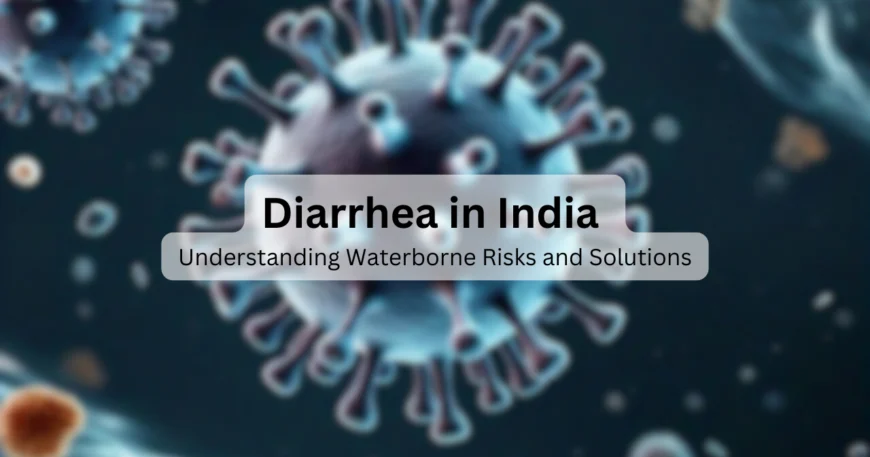Introduction
Diarrhea remains a leading public health challenge in India, contributing to significant morbidity and mortality, particularly among children under five. As a waterborne disease, its prevalence is closely tied to inadequate sanitation and contaminated water sources. With monsoons intensifying risks, understanding how to prevent and manage diarrhea is critical for communities across India.
Why Diarrhea Thrives in India’s Water
India’s rapid urbanization, overcrowding, and seasonal floods create ideal conditions for water contamination. Key pathogens include:
- Bacteria: E. coli, Vibrio cholerae (cholera).
- Viruses: Rotavirus (leading cause in children).
- Parasites: Giardia, Cryptosporidium.
Risk Factors in India:
Monsoon Rains: Flooding spreads sewage into water supplies.
Poor Sanitation: 15% of rural India practices open defecation (NFHS-5, 2021).
Overcrowding: Slums and rural areas lack clean water infrastructure.
Cultural Practices: Street food consumption, ritual water use in festivals.
Prevention: Breaking the Fecal-Oral Cycle
1.Water Purification:
- Boil water for 10+ minutes.
- Use chlorine tablets or affordable ceramic filters.
2.Hand Hygiene: Soap-based washing before meals/post-defecation.
3.Sanitation: Promote toilet use via Swachh Bharat Abhiyan.
Food Safety: Avoid raw vegetables washed in untreated water.
4.Community Action: NGOs like Sulabh International and WaterAid India drive toilet construction and rainwater harvesting projects.
Effective Treatment: Saving Lives
- ORS + Zinc: Reduces duration and severity. Free ORS packets at ASHA centers.
- Homemade Solution: 1 liter water + 6 tsp sugar + ½ tsp salt.
- Avoid Antibiotics: Misuse worsens resistance; only use if prescribed.
- Seek Help: If symptoms persist >48 hours or with blood in stool.
Government Initiatives
- Jal Jeevan Mission: Aims for piped water to all rural households by 2024.
- Swachh Bharat Abhiyan: Reduced open defecation by 60% since 2014.
- National Oral Rehydration Therapy Program: Distributes ORS via Anganwadi centers.
FAQs
Q1. Can diarrhea be fatal?
Yes, severe dehydration can kill within hours, especially in children.
Q2. Is bottled water safe?
Check for ISI certification; many brands lack proper filtration.
Q3. Does lemon juice cure diarrhea?
No, but it may aid hydration. Prioritize ORS.
The Role of Wastewater Management and Water Purification in Preventing Diarrhea
Diarrhea, a leading cause of illness and death in developing countries like India, is often linked to contaminated water and poor sanitation. Effective wastewater management and water purification are critical strategies to break the cycle of waterborne diseases. By addressing these issues, communities can significantly reduce the prevalence of diarrhea and improve public health outcomes.
1. Wastewater Management: Breaking the Contamination Chain
Wastewater management involves the collection, treatment, and safe disposal of sewage and industrial effluents. When untreated wastewater enters water bodies, it contaminates drinking water sources, spreading pathogens like E. coli, Vibrio cholerae, and Rotavirus—key culprits behind diarrhea.
Key Steps in Wastewater Management:
- Sewage Treatment Plants (STPs): Modern STPs use physical, chemical, and biological processes to remove contaminants before releasing water back into the environment.
- Decentralized Systems: In rural areas, small-scale systems like septic tanks and biogas digesters can treat household waste effectively.
- Preventing Open Defecation: Initiatives like Swachh Bharat Abhiyan have reduced open defecation, minimizing fecal contamination of water sources.
Impact on Diarrhea Prevention:
Proper wastewater management reduces the risk of pathogens entering water supplies, directly lowering the incidence of waterborne diseases like diarrhea.
2. Water Purification: Ensuring Safe Drinking Water
Even with improved wastewater management, water purification is essential to ensure that drinking water is free from harmful microorganisms and chemicals.
Common Water Purification Methods:
- Boiling: Boiling water for 10+ minutes kills most pathogens, making it safe to drink.
- Chlorination: Adding chlorine tablets or liquid to water effectively disinfects it.
- Filtration: Ceramic filters, sand filters, and modern RO systems remove bacteria, viruses, and parasites.
- UV Treatment: Ultraviolet light systems destroy the DNA of microorganisms, rendering them harmless.
Community-Level Solutions:
- Household Water Treatment (HWTS): Affordable options like clay filters or solar disinfection (SODIS) are ideal for rural areas.
- Public Water Purification Plants: Municipalities must ensure treated water meets safety standards before distribution.
Impact on Diarrhea Prevention:
Access to purified water eliminates the primary route of diarrheal infections, significantly reducing cases, especially among vulnerable populations like children and the elderly.
3. Integrated Approaches for Maximum Impact
Combining wastewater management and water purification creates a holistic solution to prevent diarrhea:
- Policy and Infrastructure: Governments must invest in sewage treatment facilities and enforce regulations to prevent industrial pollution.
- Public Awareness: Educating communities about the importance of safe water and sanitation practices fosters behavioral change.
- Technology and Innovation: Leveraging advanced technologies like AI for water quality monitoring and low-cost purification devices can enhance efficiency.
Conclusion :
Diarrhea’s toll on India is preventable. By combining individual vigilance (water purification, hygiene) with systemic efforts (government schemes, NGO partnerships), communities can curb outbreaks. Share this knowledge to empower others—safe water is a right, not a privilege.






